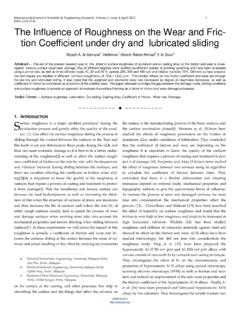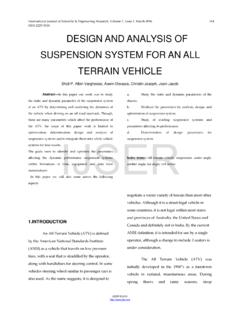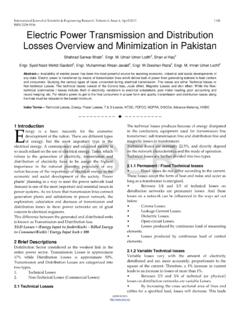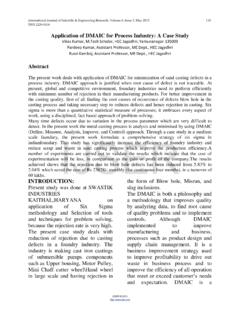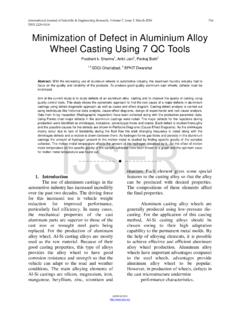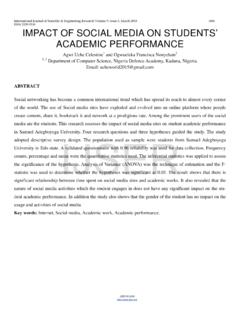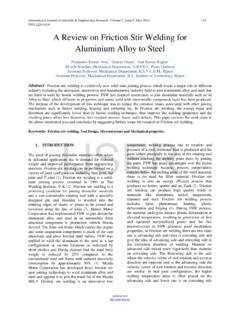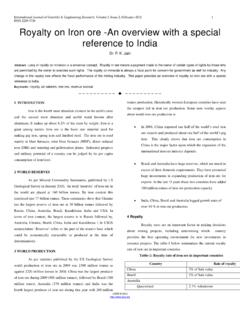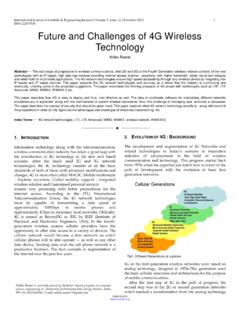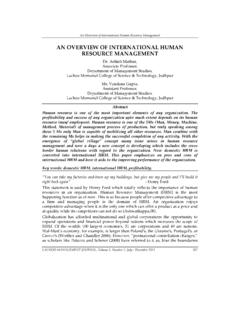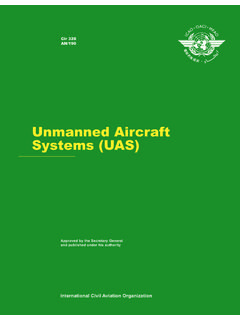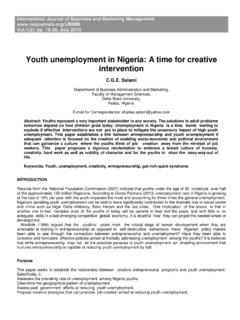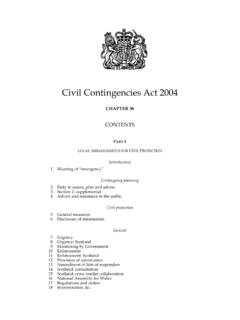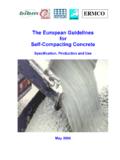Transcription of Analysis and Design of RCC Box Culvert - IJSER
1 ABSTRACT : Culverts are required to be provided under earth embankment for crossing of water course like streams, Nallas etc. across the embankment, as road embankment cannot be allowed to obstruct the natural water way. The culverts are also required to balance the flood water on both sides of earth embankment to reduce the flood level on one side of road thereby decreasing the water head consequently reducing the flood menace. This paper deals with study of some of the Design parameters of box culverts like angle of dispersion or effective width of live load, effect of earth pressure and depth of cushion provided on top slab of box culverts. Depth of cushion, coefficient of earth pressure for lateral pressures on walls, width or angle of dispersion for live loads on box without cushion and with cushion for structural deformations are important items.
2 Keywords: angle of dispersion, box Culvert , coefficient of earth pressure, cushion, lateral earth pressure etc. 1. INTRODUCTION Box Culverts consists of two Horizontal and two vertical slabs built monolithically are ideally suited for a road or railway bridge crossing with high embankments crossing a stream with a limited flow. If the discharge in a drain or channel crossing a road is small, and if the bearing Capacity of the soil is low, and then the box Culvert is an ideal bridge structure. This is a reinforced concrete rigid frame box Culvert with square or rectangular openings are used up to spans of 4m. The height of the vent generally does not exceed 3m. [1] Box culverts are economical due to their rigidity and monolithic action and separate foundation are not required since the bottom slab resting directly on the soil, serves as raft slab. For small discharges, single celled box Culvert is used and for large discharges, multicelled box culverts can be employed.
3 The barrel of the box culverts should be sufficient length to accommodate the carriageway and the kerb. For a box Culvert , the top slab is required to withstand dead loads, live loads from moving traffic, earth pressure on sidewalls, water pressure from inside, and pressure on the bottom slab besides self weight of the slab. The structure is designed like a rigid frame adopting moment distribution method for obtaining final distributed moments on the basis of the relative stiffness of the slab and vertical walls. The method is well known and does not need any elucidation. A few things like depth of cushion, coefficients of earth pressure for lateral pressure on walls, width or angle of dispersion for live loads on box without cushion and with cushion for structural deformation are important items where opinion of the designers vary and need to be dealt in much detail.
4 These affect the Design significantly and therefore, required to be assessed correctly for designing a safe structure. Therefore an attempt is made to study the effects of cushion, co-efficient of earth pressure and angle of dispersion for live load. [2] 2. HISTORICAL DEVELOPMENT David Z. Yankelevsky [3] has analyzed Rigid Box Buried in Non-linear medium by considering different parameters. The study deals with the Design parameters like compressibility, stiffness, settlement, slope of trench wall on displacement and stress variations with depth. Kiangsi Kim and [4] has evaluated Design loading on deeply buried Box Culverts. Linear and non linear finite element analyses were used to investigate the effective density or soil-structure interaction factor for deeply buried box culverts. ABAQUS (1998) and ISBILD were used primarily for the Analysis and CANDE -89 for verification and comparison.
5 Analysis and Design of RCC Box Culvert Neha Kolate1, Molly Mathew2, Snehal Mali3 1 student, Civil Engineering Department, Saraswati College of Engineering, Maharashtra, India, 2 Asst. Professor, Civil Engineering Department, Saraswati College of Engineering, Maharashtra, India, 3 Lecturer, Civil Engineering Department, Saraswati College of Engineering, Maharashtra, India, International Journal of Scientific & Engineering Research, Volume 5, Issue 12, December-2014 ISSN 2229-5518 36 IJSER 2014 IJSER Fig1: Installation of Embankment, Trench and Imperfect trench Culvert Richard M. Bennett, Scott M. Wood, Ericc Drumm and N. Randy Rainwater [5] have analyzed vertical loads on concrete box culverts under high embankments. Vibrating wires, strain gages and pressure cells were used to determine the internal forces and pressures on the Culvert due to backfill.
6 Strong correlation was obtained between between the height of fill and the pressure and internal forces in the Culvert , suggesting that the soil structure interaction factor is independent of H/B ratio. Fig 2 : Cross section of embankment and Culvert Ali Abolmaali and Anil K. Garg has evaluated the shear capacity of the precast reinforced concrete box culverts. Six full-scale m (8 ft) span box culverts were tested to failure by subjecting eact Culvert to the AASHTO HS-20 wheel load. Each test specimen Was loaded incrementally up to failure in which crack initiation and propogation were identified and recorded in each load step. In some specimens the top slab compression distribution steel was precluded during specimen fabricatio the effect of which was shown to be insignificant to Culvert s performance experimentally. 3. Design CONSIDERATIONS: CO-EFFICIENT OF EARTH PRESSURE The earth can exert pressure, minimum as active and maximum as passive, or in between called pressure at rest.
7 It depends on the condition obtained at the site. [7]. In cases where the structure is constructed before the backfill earth is placed in position and the situation is such that structure is not in position to yield on either side, the earth pressure shall reach a state at rest. In such situation the coefficient of earth pressure shall be more than active condition. In case of box since it is confined with earth from both sides the state of earth shall be at rest and a co-efficient more than the active pressure is normally adopted in the Design . The earth is filled after construction of the box further the box is not in a position to move/yield therefore the pressure shall be at rest. The co-efficient of earth pressure in case of box is taken to be for a soil having = 300 or may take value for normal soil having = 300. Coulomb s theory is acceptable.
8 All abutments and return walls shall be designed for a live load surcharge equivalent to earth fill. [8] EFFECTIVE WIDTH Effective width in the run of Culvert (length across span) is expected to be affected by a moving live load. This width plays a significant role as far as consideration of live load in the Design of Culvert . [9] bef = e (1 a/L0) + b1 bef = The Effective width of slab on which load acts. L0 = Effective span. a = The distance of the centre of gravity of the concentrated load from the nearer Support. B1 = The breadth of concentration area of the load. = A constant having the following values depending upon ratio b / L0 . Table 1: Values of constant b/L0 for slab for slab b/L0 for slab for slab Where however, there is large cushion the live load gets dispersed on a very large area through the fill and the load per unit area becomes less and does not remain significant for the Design of box, particularly in comparison to the dead load due to such large cushion.
9 In case of dead load or uniform surcharge load the effective width has no role to play and such loads are to be taken over the entire area for the Design . International Journal of Scientific & Engineering Research, Volume 5, Issue 12, December-2014 ISSN 2229-5518 37 IJSER 2014 IJSER CUSHION A box Culvert can have more than single cell and can be placed such that the top slab is almost at road level and there is no cushion. A box can also be placed within the embankment where top slab is few meters below the road surface and such boxes are termed with cushion. The size of box and the invert level depend on the hydraulic requirements governed by hydraulic designs. The height of cushion is governed by the road profile at the location of the Culvert . While calculating weight of cushion on top slab, some designers take average height of earth fill coming over full length of box including sloping side fill.
10 [2] LONGITUDINAL FORCE / BRAKING FORCE Consideration of Braking Force is another area where opinion of the designers varies in two ways firstly, whether braking force caused by moving loads shall deform the box structure and should therefore be considered in the Design of box. Secondly, if it is to be considered what effective width should be taken to obtain force and moment per unit run of the box. Effect of braking force on bridge structures without bearing, such as arches, rigid frames etc; shall be calculated in accordance with approved methods of Analysis of indeterminate structures. For the structures, generally below the level of the top of the bed block, the impact percentage shall be multiplied by the factor [8] given below: 1. For calculating the pressure at the bottom surface of the bedrock 2. For calculating the pressure on the top 3m of the structure below (decreasing the bed rock uniformly to zero) 3.

